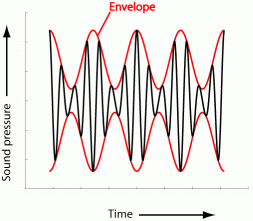Intermediate Timescale Phenomena
The effect musicians refer to as 'timbre' has a negative definition: "That which distinguishes two sounds having the same pitch and loudness" Leaving aside the spectral response, the major contribution to timbre is due to 'Intermediate timescale phenomena', which are events that take place over roughly ³10ms (natural string vibrato, for example.)
- Rise Time
- Decay Time
- Vibrato/Envelope Effects
- Rise Time
If we look at a graph of a sound's intensity (loudness) varies over time, such as the following pulse:

Sound Pulse; Intensity vs Time
The rise time is the time it takes for the sound to go from 1/e (=37%)of the maximum height to the pulse's maximum value.
This is similar to what musicians call attack. Some noises are perceived as very 'loud' when it has a small rise time (quickly reaches full intensity), yet may have quite a low intensity. Television advertising often makes use of this technique, which is why 'ads' often seem louder than anything else on television.
-
Decay Time
The decay time is the mirror image of the rise time; it is the time it takes for a sound pulse to go from its peak value down to 1/e (37%) of the maximum.
This is directly related to what musicians often refer to as sustain.
Lovers of guitar music tend to prefer a sound that has a relatively long sustain. Guitars that exploit mechanical coupling such as the 12-string and the resonator produce sounds characterised by a high sustain.
Comparing the rise to the decay times tells us something about the time symmetry of a sound. A 'pure tone' sine wave has equal decay and rise time; whereas the sound of breaking glass has a small rise time but a much larger decay time.
- Vibrato/Envelope Effects
The envelope of a wave system indicates how the wave peaks behave. Some types of envelope signatures are quite noticeable in musical sounds. A great example of this is the tremolo effect, an effect favoured by 60's rock guitarists---the sound intensity is smoothly increased and decreased sinusoidally over time, giving a 'wavy' feel to the sound.

Diagram of the "tremolo effect". Notice the fluctuating envelope.
|

